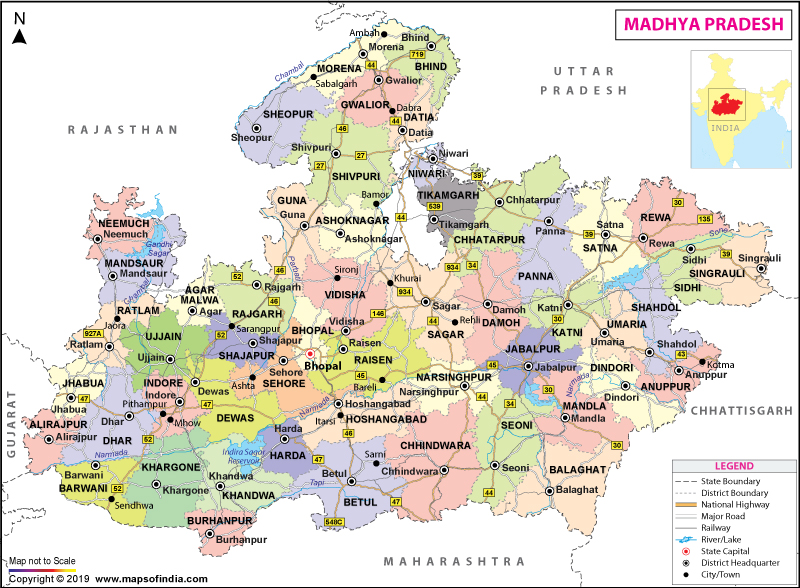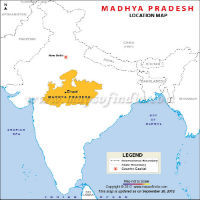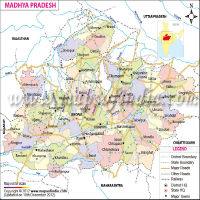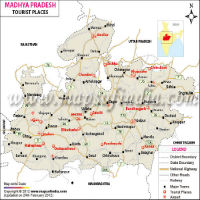About Madhya Pradesh
Landlocked in the central part of the country, Madhya Pradesh is bordered by the states of Rajasthan to its northwest, Uttar Pradesh to its north, Chhattisgarh to its east, Maharashtra to its south, and Gujarat to its west. Madhya Pradesh had the honour of being the largest state of the country until Chhattisgarh was carved out of it on November 1, 2000.
Madhya Pradesh has a mixed topography that consists of both hills and plains. The state has three predominant seasons: winter (November to February), summer (March to May), and the monsoon season (June to September). During the winter, average temperatures range from 10° to 27° C (50° to 81° F). Summers are hot, with an average temperature of 29° C (85° F) and a high temperature that at times reaches 48° C (118° F). During the monsoon season average temperature lies between average 19° to 30° C (66° to 86°). Madhya Pradesh receives an average annual rainfall of about 1200 mm (nearly 50 inches), of which 90 percent falls during the monsoon season. The capital of the state is Bhopal.
Facts on Madhya Pradesh | |
|---|---|
| Official Website | www.mp.nic.in |
| Date of Formation | Nov 1, 1956 |
| Area | 308,244 sq km |
| Density | 236/Km2 |
| Population (2011) | 72,626,809 |
| Males Population (2011) | 37,612,306 |
| Females Population (2011) | 35,014,503 |
| No. of District | 51 |
| Capital | Bhopal |
| Rivers | Narmada, Tapti, Ken, Betwa, Son, Chambal |
| Forests & National Park | Bandhavgarh NP, Kanha NP, Pench NP, Kheoni WS |
| Languages | Punjabi, Malvi, Nimadi, Punjabi, Bhilodi, Gondi, Korku, Kalto, Nihali |
| Neighbours State | Maharashtra, Gujarat, Rajasthan, Uttar Pradesh, Chhattisgarh |
| State Animal | Swamp Deer |
| State Bird | Paradise Fly-catcher |
| State Tree | Banyan |
| Net State Domestic Product (2011) | 32222 |
| Literacy Rate (2011) | 82.91% |
| Females per 1000 males | 930 |
| Assembly constituency | 230 |
| Parliamentary constituency | 29 |
History of Madhya Pradesh
The history of Madhya Pradesh goes back to the time of Ashoka, the great Mauryan ruler. A major portion of central India was a part of the Gupta Empire (300-550 AD). In the first half of the seventh century, the state was a part of the domains of the famous emperor Harsha. The closing part of tenth century was a period of confusion. In the early eleventh century, the Muslims entered central India, Mahmud of Ghazni was first, while Muhammad Ghori who incorporated certain parts with Sultanate of Delhi was second. It also formed a part of the Mughal Empire with the rise of Marathas. Till the death of Madhoji Scindia in 1794, Marathas ruled supreme in central India, but after that independent and smaller states came into being. The disintegrated smaller states paved way for British sovereignty. Some great women rulers of the region like Rani Ahilyabai Holkar of Indore, Gond queen Rani Kamla Devi and Rani Durgawati have carved a niche for themselves in history.
When India became independent in 1947, the British Indian province of Central Provinces and Berar formed Madhya Pradesh. Boundary changes followed and finally the state of Chhattisgarh was carved out of Madhya Pradesh. More...
Population
Madhya Pradesh is situated in the heart of India. Also known as 'MP', the state spreads across an area of 3,08,244 sq. km, making it the second largest state in India. Bhopal serves as the capital of Madhya Pradesh. Indore happens to be the largest city, while Jabalpur is the most important commercial center of the state. Madhya Pradesh is the sixth largest state in India by population. It shares its borders with Uttar Pradesh, Maharashtra, Chhattisgarh, Gujarat and Rajasthan. More...
Geography
The geography of this state in India mainly includes its location on earth, area and area-wise divisions, rivers, weather, soil, crops, topography as well as its flora and fauna. With its geographical location at 22.42° N and 72.54° E, Madhya Pradesh lies in central India. The state shares its borders with Uttar Pradesh to its north eastern side, Rajasthan to its north western side, Gujarat to its western side, Chhattisgarh to its south eastern side and Maharashtra to its southern side. More...
Education
Madhya Pradesh education system is very well developed. The over all school level education at Madhya Pradesh is classified into three groups - primary, middle and high school education. Madhya Pradesh has schools for polytechnics, industrial arts and crafts, music, etc. Moreover, there are 12 state universities. The schools located at Ujjain and Sagar are the oldest and finest in western region of India because of the quality of education. Recently the Madhya Pradesh education system had introduced various workshops and training sessions to influence those dropouts from schools and colleges to take up study once more. More...
Languages
Since Madhya Pradesh is frequently designated as the 'Heart of India', it is quite obvious that the prevailing regional dialect among all the languages in Madhya Pradesh happens to be Hindi. It is predominantly spoken by the inhabitants who reside in the northern and central realm of India. As a matter of fact, Hindi also cherishes the status of being one of the official languages that is employed by the union government of India. The Devanagiri script in concert with the Perso-Arabic script primarily serves the writing medium for Hindi. Apart from India, Hindi is also spoken in Pakistan, Nepal and Fiji. More...
Economy and Infrastructure
Agriculture is the basis of Madhya Pradesh's economy. Less than half of the land area is cultivable; however its distribution is quite uneven because of variations in topography, rainfall, and soils. The main cultivated areas are found in the Chambal valley, the Malwa Plateau, the Rewa Plateau, and the Chhattisgarh Plain. The Narmada valley, covered with river-borne alluvium, is another fertile area. The most important crops are rice, wheat, sorghum (jowar), corn (maize), pulses (legumes such as peas, beans, or lentils), and peanuts (groundnuts). Rice is grown principally in the East, where there is more rainfall, while in western Madhya Pradesh wheat and sorghum are more important. The state is the largest soybean producer in India. Other crops include linseed, sesame, sugarcane, and cotton, as well as inferior millets, which are grown in hilly areas. The state is a large producer of opium (in the western district of Mandasor, near Rajasthan) and marijuana (in the southwestern district of Khandwa [East Nimar]). More...
Society and Culture
Madhya Pradesh has at least four agro-climatic zones, and thus, has the most interesting mix of people and ways of life. It is home to about 40 percent of India's tribal population. There are three distinct tribal groups in the state.
Tourism of Madhya Pradesh
The state of Madhya Pradesh is literally the 'heart' of India. The state's tourism is a journey to the center of the magical and mysterious country known as India. Madhya Pradesh tourism brings to light the many monuments, exquisitely carved temples, forts and palaces that dot the state of Madhya Pradesh. Tourism lays bare the irresistible natural beauty of the state. The topography of the beautiful land is predominantly a plateau, and that plateau is interspersed by stunning mountain ranges, gurgling streams, meandering slow rivers and miles and miles of dense, thick forestland. More...
Wildlife Sanctuaries and National Parks
Madhya Pradesh wildlife tours comprise the excursions in the animal reserve forests and wildlife sanctuaries that are found in ample in Madhya Pradesh. The wildlife tours are indeed a delight to the visitors, for it provides an array of the wildlife resources. Madhya Pradesh wildlife tours chiefly imply a short trip to the national forests in order to get the feel of seeing the animals in their natural habitat. These reserve forests, unlike the real forests, are designed by human beings; yet they give the tourists a flavour of being at a forest. More...
Hotels of Madhya Pradesh
Madhya Pradesh is an important tourist destination in India. The state is home to several hotels which range from heritage to five stars to budget hotels. The hotels in Madhya Pradesh with their world class facilities and services are comparable to the best in the country.More...
Festivals
The cultural diversity of India has paved the way for the celebration of numerous fairs and festivals in all its states. Madhya Pradesh is not an exception. Its fairs and festivals are widely popular because they display the real cultural values of Indians residing in its rural areas. These fairs and festivals are not restricted to any particular community but are celebrated by all the communities. But the fairs and festivals of Madhya Pradesh that attract thousands of people are the tribal fairs and festivals whereby you get the opportunity of witnessing the tribal rituals and traditions of India. More...
Tourism in Madhya Pradesh
Madhya Pradesh, the central state of India witness travelers throughout the year. The land has everything from wildlife to beautiful caves. Here is a list of some of the best tourist places in MP:
- Bhopal
- Pench
- Kanha
- Bandhavgarh
- Pachmarhi
- Omkareshwar
- Indore
- Gwalior
- Orchha
- Jabalpur
- Mandu
- Chanderi
- Khajuraho
WBST260914GPT
Last Updated on : July 17, 2019
Travel to Madhya Pradesh
Places to visit in Madhya-Pradesh



